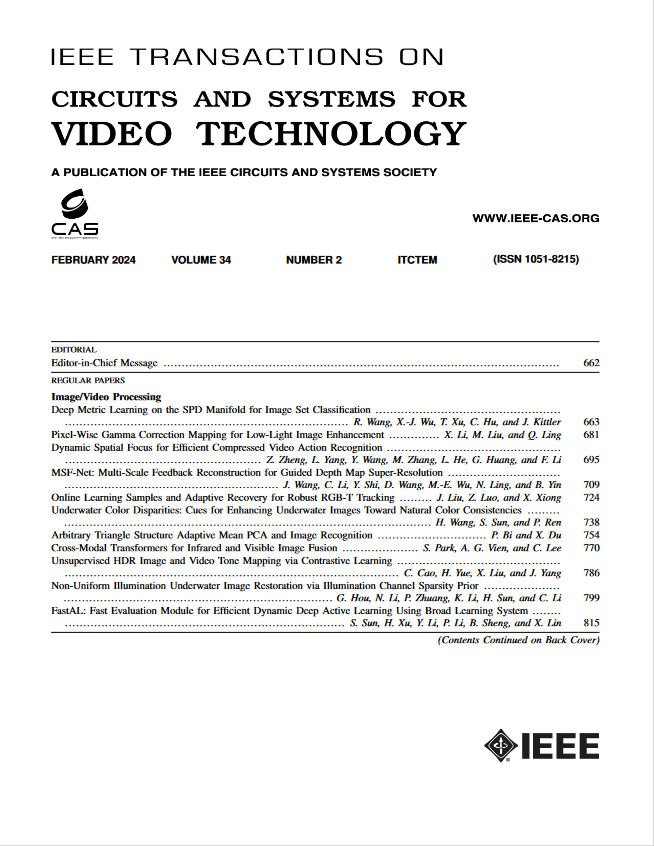利用光流引导流感知增强实时目标检测
IF 8.3
1区 工程技术
Q1 ENGINEERING, ELECTRICAL & ELECTRONIC
IEEE Transactions on Circuits and Systems for Video Technology
Pub Date : 2025-01-03
DOI:10.1109/TCSVT.2025.3525796
引用次数: 0
摘要
由于物体的快速运动和小尺度,无人机视频中的实时目标检测仍然是一个重大挑战。现有的流感知模型难以准确捕获连续帧之间的细粒度运动线索,导致动态无人机场景中的性能不佳。为了解决这些问题,StreamFlow提出了集成光流信息和增强无人机视频实时目标检测的方法。StreamFlow结合了导引动态预测(flow -Guided Dynamic Prediction, FGDP),利用局部光流信息来完善位置预测,以及考虑局部损失和光流可靠性的导引优化(optical flow Guided Optimization, OFGO)来优化模型参数。OFGO的核心是自适应流量加权(AFW)模块,该模块侧重于在训练过程中可靠的流量样本。该方法将光流与自适应加权方案相结合,显著提高了流感知模型在动态无人机环境下处理快速运动目标的能力。在四个具有挑战性的无人机视频数据集上进行的大量实验表明,与最先进的方法相比,StreamFlow在准确性方面具有优越的性能。本文章由计算机程序翻译,如有差异,请以英文原文为准。
Enhancing Real-Time Object Detection With Optical Flow-Guided Streaming Perception
Real-time object detection in Unmanned Aerial Vehicle (UAV) videos remains a significant challenge due to the fast motion and small scale of objects. Existing streaming perception models struggle to accurately capture fine-grained motion cues between consecutive frames, leading to suboptimal performance in dynamic UAV scenarios. To address these challenges, StreamFlow is proposed to integrate optical flow information and enhance real-time object detection in UAV videos. StreamFlow incorporates Flow-Guided Dynamic Prediction (FGDP) to refine position predictions using local optical flow information and Optical Flow Guided Optimization (OFGO) to optimize model parameters considering both localization loss and optical flow reliability. Central to OFGO is the Adaptive Flow Weighting (AFW) module, which focuses on reliable flow samples during training. The proposed integration of optical flow and adaptive weighting scheme significantly enhances the ability of streaming perception models to handle fast-moving objects in dynamic UAV environments. Extensive experiments on four challenging UAV video datasets demonstrate the superior performance of StreamFlow compared to state-of-the-art methods in terms of accuracy.
求助全文
通过发布文献求助,成功后即可免费获取论文全文。
去求助
来源期刊
CiteScore
13.80
自引率
27.40%
发文量
660
审稿时长
5 months
期刊介绍:
The IEEE Transactions on Circuits and Systems for Video Technology (TCSVT) is dedicated to covering all aspects of video technologies from a circuits and systems perspective. We encourage submissions of general, theoretical, and application-oriented papers related to image and video acquisition, representation, presentation, and display. Additionally, we welcome contributions in areas such as processing, filtering, and transforms; analysis and synthesis; learning and understanding; compression, transmission, communication, and networking; as well as storage, retrieval, indexing, and search. Furthermore, papers focusing on hardware and software design and implementation are highly valued. Join us in advancing the field of video technology through innovative research and insights.

 求助内容:
求助内容: 应助结果提醒方式:
应助结果提醒方式:


